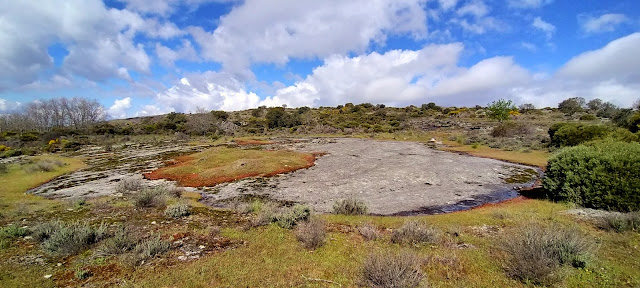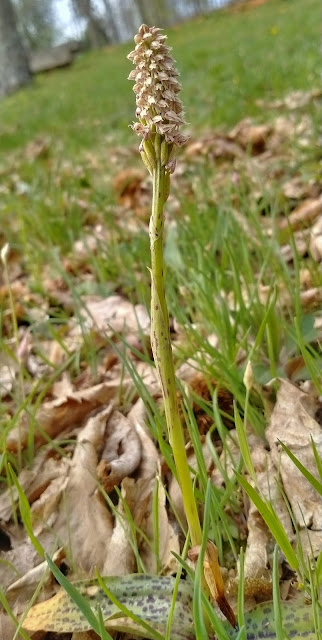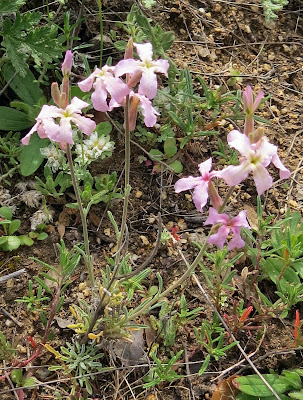In April we had a group of botanists from Denmark who came over with Danish Botanist Flemming Thorning Lund for a ten day tour.
Wednesday 20th April 2022 - Arrival day
We (Vega and Alfonso) set out to meet the
travellers at the airport, only to discover on passing Avila that an unexpected
snowstorm (still falling) had shut down the motorway to Madrid AND the national
road, so we had no option but to wait and watch the snow fall. At one moment we were joined by a Wheatear
which perched on the roadside barrier, and then flew under the car in front of
us, no doubt looking for some shelter from the falling snow. After a one and a half hour wait we finally
set off again and join a now cleared motorway, in a landscape of snow covered
conifers more appropriate to Scandinavia than to Spain.

Meanwhile our Danish friends, notified of the
situation, had landed safely and were having lunch at the airport, so, after
joining them and collecting the hire vehicle (a high-tech automatic Mercedes
Vito which put Alfonso’s driving skills to the test) we finally set off towards
the western edge of Salamanca province, to the village of San Felices de los
Gallegos. Here thankfully the skies were
much clearer and the temperature around 16 degrees, with only a chilly breeze
to remind us that part of central Spain was under five centimetres of snow.
We settled into our accommodations, at Hotel
Mesa del Conde and Casa Rural Corral de las Arribes, and after a glass of local
Juan Garcia wine we all sat down to supper in Mesa del Conde.
Thursday 21st April - San Felices
After a visit to the castle grounds of San
Felices, where there were carpets of Silvery whitlow wort Paronychia argentea
and Sandy stonecrop Sedum arenarium on
the ground, and spotting our first Swift of the year, we drove down towards the
river Agueda. We explored an ancient enclosure for animals with some stone
shepherds’ huts and spent the next couple of hours looking at the plants along
a path between dry-stone walls, with vistas over terraces of olive trees and rocky
outcrops across the valley, where nesting Griffon vultures eventually began to
lift off and circle above.
 |
| Paronychia argentea |
Among many plants of interest were a tiny
Cistus Halimium umbellatum (subsp. Viscosum?);
a beautiful red Toadflax Linaria
aeruginea; Star of Bethlehem Ornithogalum
possible subspecies baeticus?
which was just beginning to flower and an endemic white Thrift Armeria alliacea subsp. matritensis.
 |
| Halimium umbellatum |
 |
| Linaria
aeruginea |
 |
| Ornithogalum | |
 |
| Armeria alliacea | | | |
Trees of interest were the Terebinth or
Turpentine tree Pistacia terebinthus (named
“cornicabra” for its gall in the shape of a goat’s horn); Portuguese oak Quercus faginea and the Hackberry Celtis australis, there was also wild
Honeysuckle, Lonicera arborea.
 |
| Pistacia terebinthus |
 |
Pistacia terebinthus flower
|
 |
| Quercus faginea |
We also saw Small copper Lycaena phlaeas and Wall brown Lasiomatta
megera butterflies, Iberian magpie, Iberian chiffchaff, Barn swallow and
House martin.
 |
| Lycaena phlaeas |
 |
| Lasiomatta
megera |
After a short walk in some meadows between Holm
oaks Quercus ilex rotundifolius we
returned to the hotel for lunch. Later we
set off towards the Castro at Yecla, a hill fort constructed by the Veton
people, the pre-Roman denizens also responsible for carving large granite boars
and defending their hill forts with an external area of up-ended stones. We
stopped on the way to see a field full of Champagne orchids Orchis morio champagneuxii, and to watch
an Egyptian vulture flying over the fields, and en route saw Iberian shrike and
Stonechat.
 |
Botanists in the field
|
 |
| Orchis morio champagneuxii |

 |
Yecla la Vieja
|
Friday 22nd April Arribes Natural Park
A rainy morning as we
headed to our first stop above the confluence of the Huebra and Camaces rivers
where, had it not been raining we had hoped to see Griffon and Egyptian vulture,
Bonelli’s eagle and Blue Rockthrush. We headed
down to the bridge and the rain eased enough to search for plants at the base
of the cliffs.
Here were some good examples of the Iberian endemic
Anarrhinum duriminium, several
splendid Broomrapes Orobanche gracilis?,
a Brown bluebell Dipcadi serotinum,
the pale yellow Andryala integrifolia,
Spiny starwort Pallenis spinose,
Tuberaria guttata and the White-leaved rockrose Cistus albidus.
 |
| Anarrhinum duriminium |
 |
| Cistus albidus |
 |
| Dipcadi serotinum |
 |
| Orobanche |
 |
| Pallenis spinose |
 |
| Tuberaria guttata |
The
rain put paid to the planned picnic, so had coffee at Vilvestre and returned
for lunch at the hotel, having decided to visit the Olive oil press museum ‘El
Lagar del mudo’ after lunch. After an
excellent guided visit by Dani to this wonderful museum, the weather seemed to
improve, so we drove down to see the Duero river at Vega Terron, and found a
few more Anarrhinum duriminium plants
at the base of the cliff here.
 |
El
Lagar del mudo | Supper at Mesa del Conde
|
|
Saturday 23rd April - Sierra de Francia and
Batuecas Natural Park
We set off towards the Sierra de Francia with
still more rain, good for the earth and the plants but not so conducive to being
outdoors. So, after coffee in el Cabaco we drove to La Alberca and had a look
at the exhibitions in the Casa del Parque information centre, including my own oak-carved
sculptures on show there. A walk in the
rain down to the historic centre of La Alberca and back to Porta Coeli for
lunch. In the afternoon the weather improved so first we looked at the plants around
the hotel, finding some Aristolochia
paucinervis, in the undergrowth, and
a small cistus, Helianthemum
violaceum growing out of the rocks.
 |
| Aristolochia
paucinervis |
 |
| Helianthemum
violaceum | | |
|
After lunch
we drove to Las Batuecas, stopping at the Puerto del Portillo at 1250m to see
the Halimium lasianthum, which was
just beginning to flower there. We then
drove down to the very verdant Batuecas river valley, at 580m. The boardwalk runs parallel to the Batuecas
river through a mixture of Strawberry tree, Arbutus
unedo; Mastic tree, Pistacia
lentiscus; False olive Phillyrea angustifolia; Holly, Ilex auquifolium; Holm
and Cork oak, Quercus ilex and suber.
The forest floor was carpeted with a mix of mosses, ferns, and flowers
such as Arenaria montana.
 |
| Halimium lasianthum |
 |
River Batuecas
|
 |
| Arenaria montana |
Growing from the valley sides above
were Cade juniper, Juniperus oxycedrus;
White tree heather, Erica arborea; Rock
roses Cistus ladanifer and Cistus populifolius, and Genista tridentata, the last two just
beginning to flower.
 |
| Erica arborea |
 |
| Cistus ladanifer |
 |
| Cistus populifolius |
 |
| Genista tridentata |
 |
| Cistus salvifolius |
On the way back to the hotel we stopped to look
at Cistus salvifolius and a Cistus ladanifer with no purple spots.
Sunday 24th April – Sierra de Francia San
Martin and San Esteban
At breakfast Hans said
he had seen a Golden Oriole, I too went out and heard it call. The first one
this year for us. The morning was spent
exploring the village of San Martin del Castañar, with medieval half-timbered
houses and cobbled streets and plenty of house martins, barn swallows and newly
arrived swifts livening up the square.
Flemming found a dandelion which could be Taraxacum hispanicum, and we discovered
two Iberian endemics: Antirrhinum
graniticum and Linaria spartea
growing from the walls.
 |
San Martin del Castañar
|
 |
| Taraxacum hispanicum |
 |
| Antirrhinum
graniticum |
 |
| Linaria spartea |
We then had a brief
stroll along a path between granite boulders and various brooms, only to find
that a levelling machine had destroyed the verges and there was little left:
some Arenaria montana and Shepherd’s
cress Teesdalia nudicaulis.
More interesting, on the roadside were: Halimium
umbellatum, Lupin Lupinus hispanicus
and the minute Ornithopus compressus. We tried another path lower down, and found
some Leucanthemopsis Pulverulenta,
endemic to the central Iberian Penninsula, and Orchis mascula.
 |
| Arenaria montana |
 |
| Teesdalia nudicaulis |
 |
| Halimium
umbellatum |
 |
| Leucanthemopsis Pulverulenta |
 |
| Lupinus hispanicus |
 |
| Orchis mascula |
 |
| Ornithopus compressu |
We returned to Porta Coeli for a light lunch
and a rest, and drove over to San Esteban de la Sierra to walk down by the
river. On approaching the ‘Roman bridge’ (mainly Romanic but built over the
remains of Roman), I spotted a pair of Hawfinch flying off across the orchards,
and Flemming immediately found another Aristolachia
pausinervis. There was Spanish Valerian Centranthus
calcitrapae, and an assortment of tiny ferns growing from the mossy stone
walls.
 |
Lunch at Porta Coeli
|
 |
Roman bridge at San Esteban
|
 |
| Centranthus
calcitrapae |
 |
| Polypodium |
 |
Ceterach officinarum |
 |
| Cystopteris
fragilis |
 |
| Asplenium trichomanes |
|
On the
bridge were some Tassel Hyacinth Muscari
comosum. We walked along by the
river listening to a nightingale in full song, and looking at meadow flowers
along the path. Here were Narrow-leaved lupin
Lupinus angustifolia, two plants of
the Borage family: Ancusa undulata
and Green alkanet Pentaglottis
sempervirens and Red vetchling Lathyrus
cicero. 
 We then walked downstream on an uphill and
drier path, crossing a stream and on between Olives, Turpentine tree and Holm
oaks. Here were, amongst others Honesty Lunaria
annua, Amethyst toadflax Linaria
amethystea subsp. amethystea and Salvia
verbenica. On our return we had a
short walk along a small Strawberry tree Arbutus
unedo woodland, where we came across some scented Solomon’s seal, Polygonatum odoratum.

Monday 25th April – Sierra de
Francia and Sierra de Bejar We started the day visiting Miranda del
Castañar, a hilltop medieval walled town with long narrow streets where the
balconies almost touch each other. We
had coffee and a good look around here.
We then headed southwest to the interesting
woodland near the village of Cepeda which, apart from Sweet chestnut Castanea sativa and Oak Quercus pirenaicus, contains relic
population of Quercus robur, survivor
of the ice age due to its low altitude (630m). There was more Arenaria montana, and a most interesting discovery for me was made
by Helle, who found a Kerry lily Simethis
mattiazzii, a dainty plant I’d never seen before with purple-budding white
flowers and hairy white filaments. Narrow-leaved
helleborine orchid Cephalanthera
longifolia was found, just coming in flower, then in an orchard above wall
level there was a host of Purple orchids, Orchis
mascula, with one in particular looking very anthropomorphic. There was also another member of the Borage
family with tiny blue flowers - Omphalodes
nitida native to the northwest of the Iberian Peninsula, and a very
attractive vetchling, Lathyrus.
  From here we headed to a pine forest on the shores
of the River Alagon where we were to eat our picnic. On entering the forest, we were greeted by a
large group of Cephalanthera longifolia
orchid in various stages of flowering.    
We had our lunch on a
granite table with benches, and no sooner had we finished, Bente found another
orchid, the tiny Dense-flowered orchid Neotinea
maculata. A bit later Yan found a
small cluster of Tongue orchid Serapias
lingua in a meadow by the river.
There was also another blue Borage to add to our list: Glandora prostrata.
We went on after
lunch to the banks of the river Sangusin. The higher altitude and recent cold
combined with the presence of sheep grazing meant that there was limited flora here,
Lesser celandine Ficaria verna in the
damp areas, and Asphodel Asphodelus albus
and Foxglove Digitalis thapsi just
coming into flower. However, the
highlight was the fauna: we observed Spanish and European pond turtle from the
bridge; amongst the rocks Algerian sand lizard Psammodromus algirus; three Black stork appeared circling above us,
we also saw Golden eagle, Booted eagle, Cuckoo, Hoopoe, and Bee-eaters. 




 View from Porta Coeli View from Porta Coeli
Tuesday 26th April - Sierra Quilama
and Salvatierra de Tormes
In the morning from
the hotel room we saw our first Red-rumped swallow of the year - they have been
nesting under the hotel terrace roof for some years - so it was a joy to
welcome them back. Leaving Hotel Porta
Coeli we headed north and east towards the village of Linares de Riofrio in the
Sierra Quilama, and the woodland of Honfria below the mountain of Pico Cervero.
We stopped by a patch of open woodland were we found more Orchis Mascula, Neotinea
maculata, Heath violet Viola canina, Primula
acaulis, Polygonatum odoratum and
Wild Peony Paeonia officinalis. We
continued up the mountain where Flemming showed us some very tiny flowering
grasses Nardus stricta and Carex humilis? and a lovely bright
yellow Geum sylvaticum. There was also
a group of Valeriana sps. and more
Rock rose (Hallimium?). Three Roe deer
were grazing on the hillside but spotted us and ran quickly over the brow of
the ridge.
   We drove back down to the village and had a
coffee, before visiting a wet granite meadow nearby. It had been grazed by cattle so was a little
disappointing, but Susanne found some Orchis
morio champagneuxii.
From here we drove straight to Salvatierra,
settled into the Hotel and after a light but delicious lunch we had a walk
around the village to see the local birds. The first bird we heard at a distance and were
privileged to see it singing on a cable about ten metres away: Nightingale. We
stopped and heard its concert for a good few minutes. Later some of the group
went back to rest and the rest of us continued birding around the village. We
saw 8 different raptors: Black and Red kite; Griffon vulture, Marsh harrier,
Golden eagle, Booted eagle, Buzzard and Kestrel, as well as Serin, Cirl bunting,
Black redstart, Spotless starling, Barn swallow, House sparrow, Corn bunting,
White stork, Thekla lark, Raven and a Whinchat, a passage migrant here.
Wednesday 27th April - Granite meadow, Monleon
and Bejar pine forest
Our first port of call was another granite
meadow, this time with more success. Serapias lingua, Tuberaria guttata, Linum bienne, some yellow composites, possibly Reichardia picroides and Broomrape Orobanche were the main species of
interest, but the beautiful moss and stonecrop covered granite pavements, with
white broom Retama monosperma and Spanish
lavender Lavandula pedunculata made
for a very lovely landscape. A field
nearby provided dozens of Champagne orchids Orchis
morio champagneuxii and Saxifraga
sps. There were plenty of birds here
too, including Blackcap, Whitethroat, Sardinian warbler, Cuckoo and Raven. 


A coffee break at the
local village of Valdelacasa, where a Golden Oriole flew by, and a visit to the
medieval walled village of Monleon came next. This village is sited above the
confluence of two rivers and was most probably the site of a Vetton hill fort,
before becoming the lovely gem it is today, strangely under visited despite
being very attractive.
Here we saw Black and Griffon vulture, Booted
eagle, Spotless starling and Rock sparrow.
Lunch
back at the hotel and after a brief rest we headed south to the textile town of
Bejar and a pine forest just above it. Just
as we arrived the rain stopped and the sun came out. This was good for orchids: Orchis morio champaneuxii, Orchis mascula,
Cephalanthera longifolia and Neotinea
maculata, plus Arenaria, and a some more Rock rose Halimium. Thursday 28th April - Puente del
Congosto
We spent the morning looking at the Mediterranean
plants along sandy granite paths near the River Tormes at Puente de Congosto. Just along the path we saw two different Ornithogalum: concinnum a species endemic to the
Central System and parts of Portugal and the much more widespread Ornithogalum umbellatum. Here was Astragalus incanus, found only in both Castillas and Morrocco, and
close by the tiny star-shaped Filago carpetana. Turid pointed out some very wilted looking Matthiola fruticulosa, a wild night-scented stock. Flemming discovered a brassica, Brassica oxyrrhina, endemic to sandy
areas in western Iberia. 
Flemming commented that this was one of the
most interesting areas in the entire trip for him, having some species which we
hadn’t seen anywhere else before.
Along the way we saw many butterflies: a very
worn Queen of Spain fritillary Issoria
lathonia and a Small copper Lycaena
phlaes were the only ones I was able to photograph.
We had a quick look around the bridge
overlooking the Tormes river, from which we saw Crag martins, swifts and
swallows, the Blue rockthrush guarding its castle and a pair of Short-toed
eagle, one of which hung long enough in the sky for everybody to see in the
telescope.
Time and a threatening storm eventually made us
make our way back to the van from where we headed off for coffee in the
neighbouring village of Santibañez. Then
back to the hotel for a late lunch and the afternoon off to rest and pack bags
for the following morning’s early journey back to the airport.
|























































































































































No comments:
Post a Comment